Analysis of Wear Resistance of Borided Steel C45
Abstract
1. Introduction
2. Materials and Methods
3. Results and Discussion
4. Conclusions
Author Contributions
Funding
Conflicts of Interest
References
- Martini, C.; Palombarini, G.; Poli, G.; Prandstraller, D. Sliding and abrasive wear behaviour of boride coatings. Wear 2004, 256, 608–613. [Google Scholar] [CrossRef]
- Dixit, T.; Singh, I.; Prasad, K.E. Room and high temperature dry sliding wear behavior of Boron modified as-cast Ti-6Al-4V alloys against hardened steel. Wear 2019, 420–421, 207–214. [Google Scholar] [CrossRef]
- Józwik, J.; Dziedzic, K.; Barszcz, M.; Pashechko, M. Analysis and Comparative Assessment of Basic Tribological Properties of Selected Polymer Composites. Materials 2020, 13, 75. [Google Scholar] [CrossRef]
- Poliakov, P.; Tisov, O.; Kornienko, A. Polymeres with enhanced energy capacity modified by semiconductor materials. Funct. Mater. 2019, 26, 629–634. [Google Scholar]
- Kindrachuk, M.V.; Volchenko, O.I.; Volchenko, D.O.; Volchenko, N.O.; Polyakov, P.A.; Kornienko, A.O.; Yurchuk, A.O. Polymeric Materials Modified by Semiconductor Substances in Friction Units of Braking Devices. J. Nano Electron. Phys. 2019, 11, e03014. [Google Scholar] [CrossRef]
- Dziedzic, K.; Paszeczko, M.; Barszcz, M.; Józwik, J. Structure and construction assessment of the surface layer of hardfaced coating after wear test. Adv. Sci. Technol. Res. J. 2017, 3, 253–260. [Google Scholar] [CrossRef]
- Meric, C.; Sahin, S.; Backir, B.; Koksal, N.S. Investigation of the boronizing effect on the abrasive wear behavior in cast irons. Mater. Des. 2006, 27, 751–757. [Google Scholar] [CrossRef]
- Hryhorenko, G.; Adeeva, L.; Tunik, A.; Karpets, M.; Korzhyk, V.; Kindrachuk, M.; Tisov, O. Formation of microstructure of plasma-arc coatings obtained using powder wires with steel skin and B4C+(Cr,Fe)7C3+Al Filler. Metallofiz. Noveishie Tekhnol. 2020, 42, 1265–1282. (In Ukrainian) [Google Scholar] [CrossRef]
- Hu, J.; Zeng, J.; Yang, Y.; Yang, X.; Li, H.; Guo, N. Microstructures and Wear Resistance of Boron-Chromium Duplex-Alloyed Coatings Prepared by a Two-Step Pack Cementation Process. Coatings 2019, 9, 529. [Google Scholar] [CrossRef]
- Cherepova, T.; Dmitrieva, G.; Tisov, O.; Dukhota, O.; Kindrachuk, M. Research on the Properties of Co-Tic and Ni-Tic Hip-Sintered Alloys. Acta Mech. Autom. 2019, 13, 57–67. [Google Scholar] [CrossRef]
- Józwik, J. Evaluation of Tribological Properties and Condition of Ti6Al4V Titanium Alloy Surface. Tech. Gaz. 2018, 25, 170–175. [Google Scholar]
- Holubets, V.M.; Pashechko, M.I.; Dzedzic, K.; Borc, J.; Tisov, A.V. Frictional Strength of Electric Spark Coatings from Powder Wires under Friction without Lubrication. J. Frict. Wear 2020, 41, 443–446. [Google Scholar] [CrossRef]
- Wang, H.; Yao, Z.; Tao, X.; Zhang, S.; Xu, D.; Oleksandr, M. Role of trace boron in the microstructure modification and the anisotropy of mechanical and wear properties of the Ti6Al4V alloy produced by electron beam freeform fabrication. Vacuum 2020, 172, 109053. [Google Scholar] [CrossRef]
- Gershman, I.S.; Bushe, N.A. Realization of dissipative self-organization on wear surface of tribosystems. J. Frict. Wear 1995, 16, 61–70. [Google Scholar]
- Günen, A.; Kanca, E.; Çakir, H.; Karakaş, M.S.; Gök, M.S.; Küçük, Y.; Demir, M. Effect of borotitanizing on microstructure and wear behavior of Inconel 625. Surf. Coat. Technol. 2017, 311, 374–382. [Google Scholar] [CrossRef]
- Zeng, J.; Hu, J.; Yang, X.; Xu, H.; Li, H.; Guo, N. Evolution of the Microstructure and Properties of Pre-Boronized Coatings During Pack-Cementation Chromizing. Coatings 2020, 10, 159. [Google Scholar] [CrossRef]
- Kul, M.; Danacı, I.; Gezer, Ş.; Karaca, B. Effect of boronizing composition on hardness of boronized AISI 1045 steel. Mater. Lett. 2020, 279, 128510. [Google Scholar] [CrossRef]
- Rodríguez-Castro, G.A.; Reséndiz-Calderon, C.D.; Jiménez-Tinoco, L.F.; Meneses-Amador, A.; Gallardo-Hernández, E.A.; Campos-Silva, I.E. Micro-abrasive wear resistance of CoB/Co2B coatings formed in CoCrMo alloy. Surf. Coat. Technol. 2015, 284, 258–263. [Google Scholar] [CrossRef]
- Martini, C.; Palombarini, G.; Carbucicchio, M. Mechanism of thermochemical growth of iron borides on iron. J. Mater. Sci. 2004, 39, 933–937. [Google Scholar] [CrossRef]
- Campos-Silva, I.; Ortiz-Domínguez, M.; Tapia-Quintero, C.; Rodríguez-Castro, G.; Jiménez-Reyes, M.Y.; Chávez-Gutiérrez, E. Kinetics and boron diffusion in the FeB/Fe2B layers formed at the surface of borided high-alloy steel. J. Mater. Eng. Perform. 2012, 21, 1714–1723. [Google Scholar] [CrossRef]
- Bartkowska, A. Production and Properties of FeB-Fe2B-Fe3(B,C) Surface Layers Formed on Tool Steel Using Combination of Diffusion and Laser Processing. Coatings 2020, 10, 1130. [Google Scholar] [CrossRef]
- Azakli, Y.; Cengiz, S.; Tarakci, M.; Gencer, Y. Characterisation of boride layer formed on Fe–Mo binary alloys. Surf. Eng. 2016, 32, 589–595. [Google Scholar] [CrossRef]
- Lindner, T.; Löbel, M.; Sattler, B.; Lampke, T. Surface hardening of FCC phase high-entropy alloy system by powder-pack boriding. Surf. Coat. Technol. 2019, 371, 389–394. [Google Scholar] [CrossRef]
- Pertek-Owsianna, A.; Kulka, M.; Jankowiak, M. The investigation of the structure and properties of borided machinery steel 41CR4 and tool steel NC4. Arch. Technol. Masz. Autom. 2006, 26, 1–12. [Google Scholar]
- Lubas, J. Tribological properties of surface layer with boron in friction pairs. Surf. Rev. Lett. 2009, 16, 767–773. [Google Scholar] [CrossRef]
- Kulka, M.; Mikołajczak, D.; Makuch, N.; Dziarski, P.; Przestacki, D.; Panfil-Pryka, D.; Piasecki, A.; Miklaszewski, A. Laser Surface Alloying of Austenitic 316L Steel with Boron and Some Metallic Elements: Microstructure. Materials 2020, 13, 4852. [Google Scholar] [CrossRef] [PubMed]
- Bartkowski, D.; Bartkowska, A.; Popławski, M.; Przestacki, D. Microstructure, Microhardness, Corrosion and Wear Resistance of B, Si and B-Si Coatings Produced on C45 Steel Using Laser Processing. Metals 2020, 10, 792. [Google Scholar] [CrossRef]
- Yushkov, Y.G.; Oks, E.M.; Tyunkov, A.V.; Corbella, C.; Zolotukhin, D.B. Deposition of boron-containing coatings by electron-beam evaporation of boron-containing targets. Ceram. Int. 2020, 46, 4519–4525. [Google Scholar] [CrossRef]
- Wu, Y.H.; Yang, H.J.; Guo, R.P.; Wang, X.J.; Shi, X.H.; Liaw, P.K.; Qiao, J.W. Tribological behavior of boronized Al0.1CoCrFeNi high-entropy alloys under dry and lubricated conditions. Wear 2020, 460–461, 203452. [Google Scholar] [CrossRef]
- Hou, J.; Zhang, M.; Yang, H.; Qiao, J.; Wu, Y. Surface strengthening in Al0.25CoCrFeNi high-entropy alloy by boronizing. Mater. Lett. 2019, 238, 258–260. [Google Scholar] [CrossRef]
- Kim, T.-S.; Yeo, J.-H.; Nam, K.-B.; Kim, M.-J.; Yoo, J.-B. Boron carbide coating to improve the chemical stability of nm-thick graphite films. Thin Solid Films 2020, 704, 138002. [Google Scholar] [CrossRef]
- Tang, F.; Wu, X.; Ge, S.; Ye, J.; Zhu, H.; Hagiwara, M.; Schoenung, J.M. Dry sliding friction and wear properties of B4C particulate-reinforced Al-5083 matrix composites. Wear 2008, 264, 555–561. [Google Scholar] [CrossRef]
- Erdemir, A.; Bindal, C.; Fenske, G.R. Formation of ultralow wear surface films on boron carbide. Appl. Phys. Lett. 1996, 68, 1637–1639. [Google Scholar] [CrossRef]
- Stott, F.H. The role of oxidation in the wear of alloys. Tribol. Int. 1998, 31, 61–71. [Google Scholar] [CrossRef]
- Pashechko, M.; Lenik, K. Segregation of atoms of the eutectic alloys Fe–Mn–C–B–Si–Ni–Cr at friction wear. Wear 2009, 267, 1301–1304. [Google Scholar] [CrossRef]
- Pashechko, M.; Dziedzic, K.; Mendyk, E.; Jozwik, J. Chemical and phase composition of the wear surfaces Fe-Mn-C-B-Si-Ni-Cr hardfacing coatings. J. Tribol. Trans. ASME 2018, 140, 021302-1–021302-5. [Google Scholar] [CrossRef]
- Barszcz, M.; Pashechko, M.; Dziedzic, K.; Józwik, J. Study on the Self-Organization of an Fe-Mn-C-B Coating during Friction with Surface-Active Lubricant. Materials 2020, 13, 3025. [Google Scholar] [CrossRef] [PubMed]
- Gershman, I.; Gershman, E.I.; Mironov, A.E.; Fox-Rabinovich, G.S.; Veldhuis, S.C. Application of the Self-organization phenomenon in the development of wear resistant materials—A Review. Entropy 2016, 18, 385. [Google Scholar] [CrossRef]
- Bakley, D. Surface Phenomena on Adhesion and Friction Interactions; Mashynostroenie: Moscow, Russia, 1986; pp. 260–264. (In Russian) [Google Scholar]
- Dziedzic, K.; Józwik, J.; Barszcz, M.; Gauda, K. Wear characteristics of hardfacing coatings obtained by tungsten inert gas method. Adv. Sci. Technol. Res. J. 2019, 13, 8–14. [Google Scholar] [CrossRef]
- Dziedzic, K.; Józwik, J.; Barszcz, M. The assessment of tribiological properties and the condition of the surface of tool steel for hot work 55NiCrMoV6 subjected to the process of friction. Manuf. Technol. 2016, 16, 69–76. [Google Scholar] [CrossRef]
- Józwik, J.; Dziedzic, K.; Usydus, I.; Ostrowski, D.; Krolczyk, G.M. Assessment of internal defects of hardfacing coatings in regeneration of machine parts. J. Cent. South Univ. 2018, 25, 1144–1153. [Google Scholar] [CrossRef]
- Paszeczko, M.; Montusiewicz, J.; Dziedzic, K.; Józwik, J. Multicriterion assessment of wear resistance of Fe–Mn–C–B eutectic coatings alloyed with Si, Ni, and Cr. Powder Metall. Met. C+ 2017, 56, 316–322. [Google Scholar]
- Pashechko, M.; Lenik, K. Segregation of atoms of the eutectic alloys Fe–Mn–C–B at friction wear. Achiev. Mater. Manuf. Eng. 2006, 18, 467–470. [Google Scholar]
- Pashechko, M.; Dziedzic, K.; Barszcz, M. Study of the structure and properties of wear-resistant eutectic Fe-Mn-C-B-Si-Ni-Cr coatings. Powder Metall. Met. Ceram. 2013, 52, 469–476. [Google Scholar] [CrossRef]
- PN/EN 10083-2. Available online: https://sklep.pkn.pl/pn-en-10083-2-1993p.html (accessed on 1 December 2020).
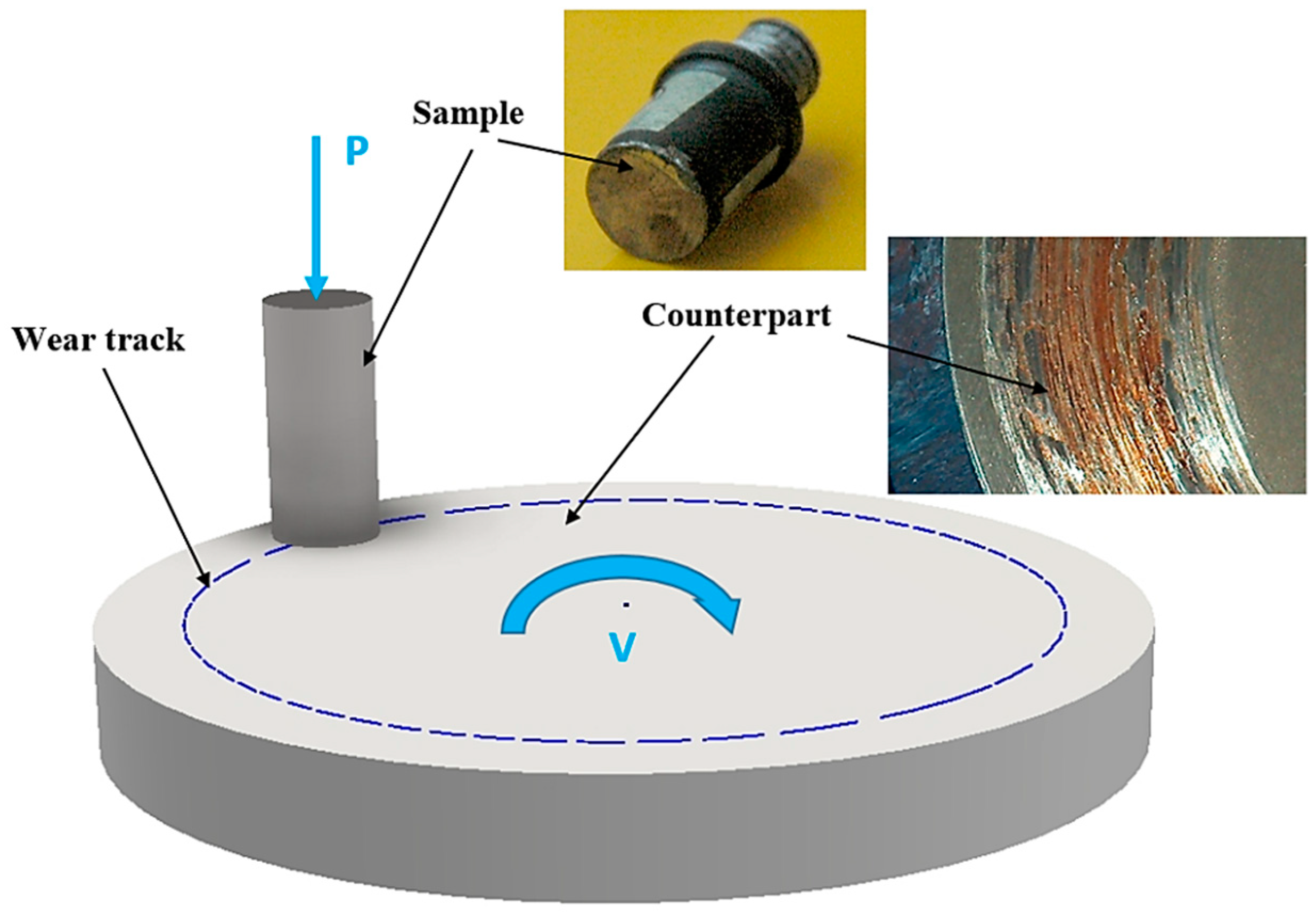
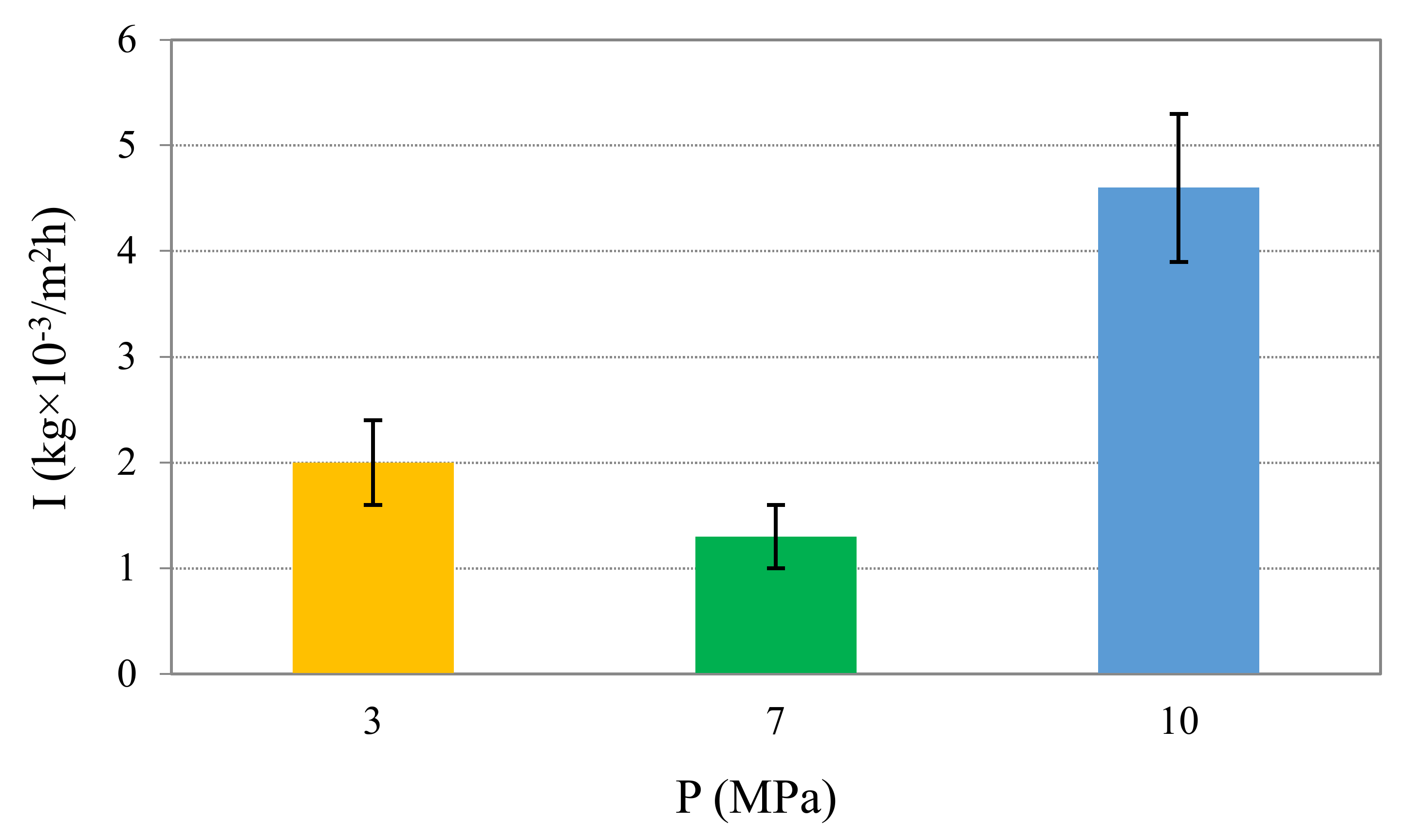

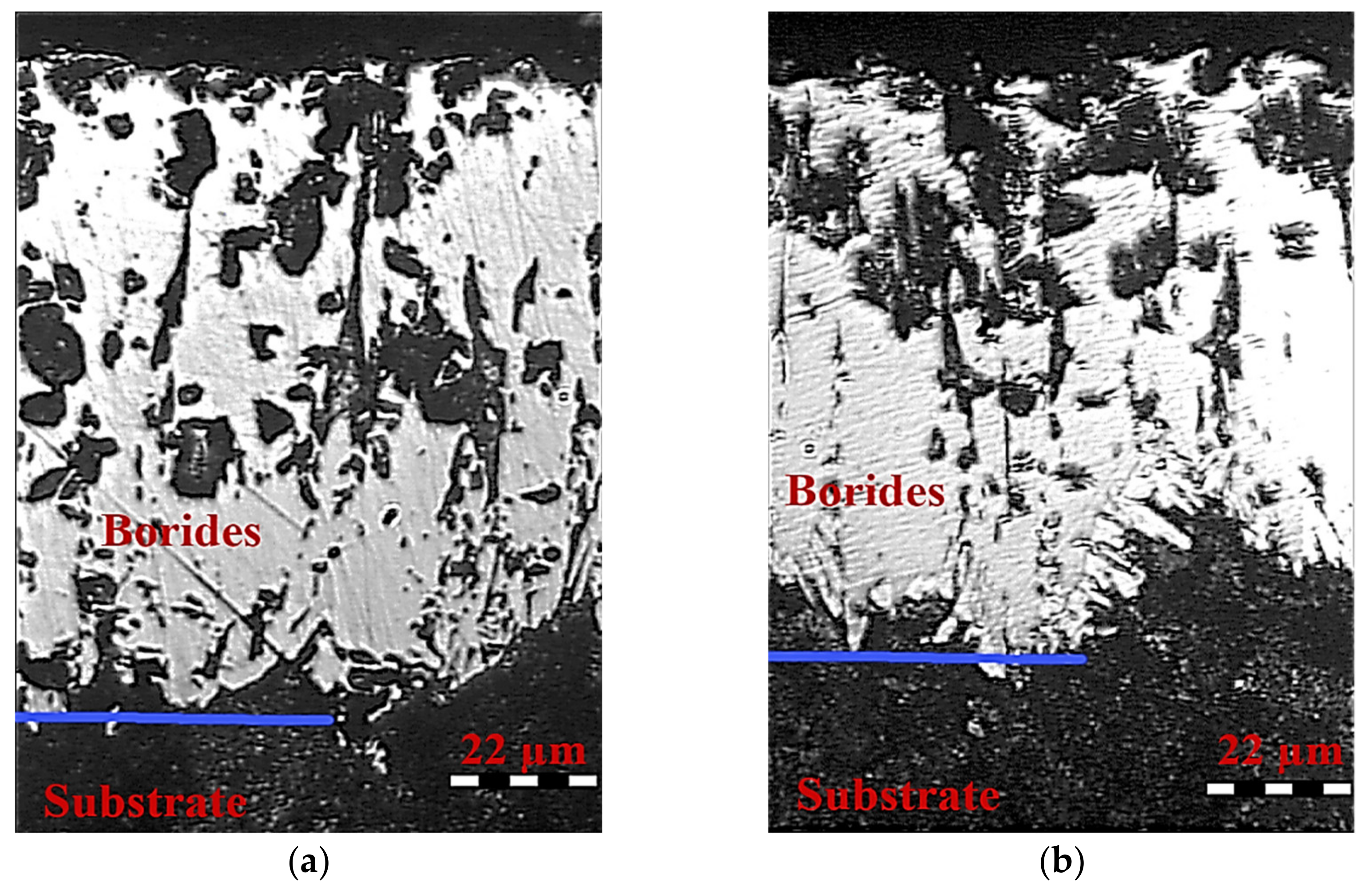
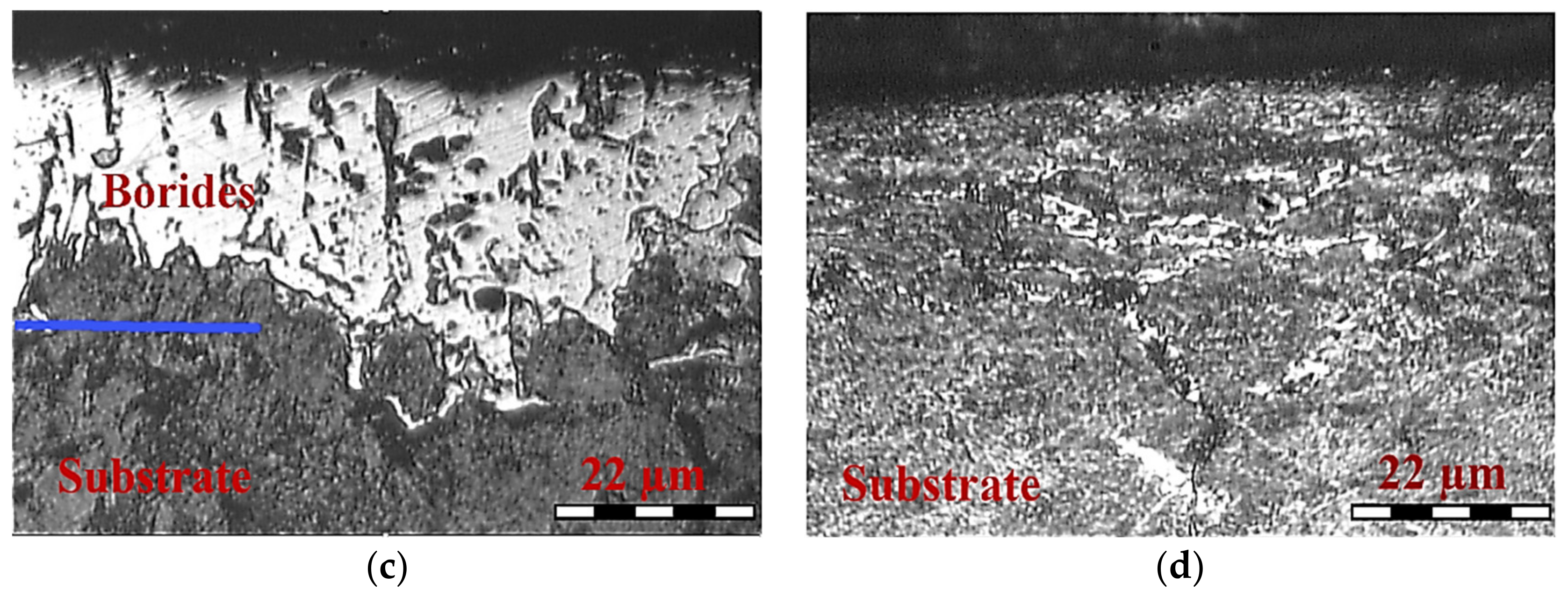
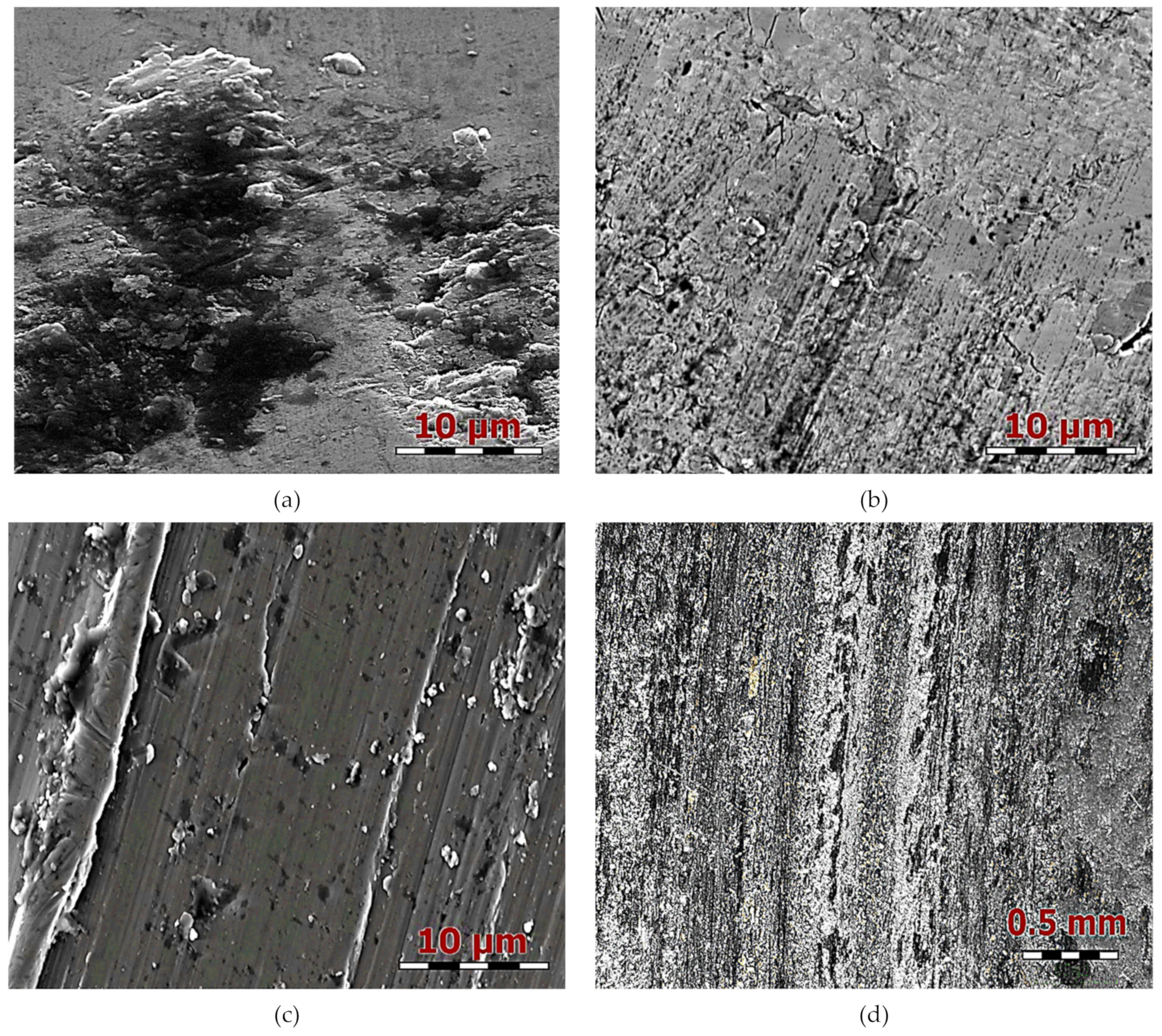
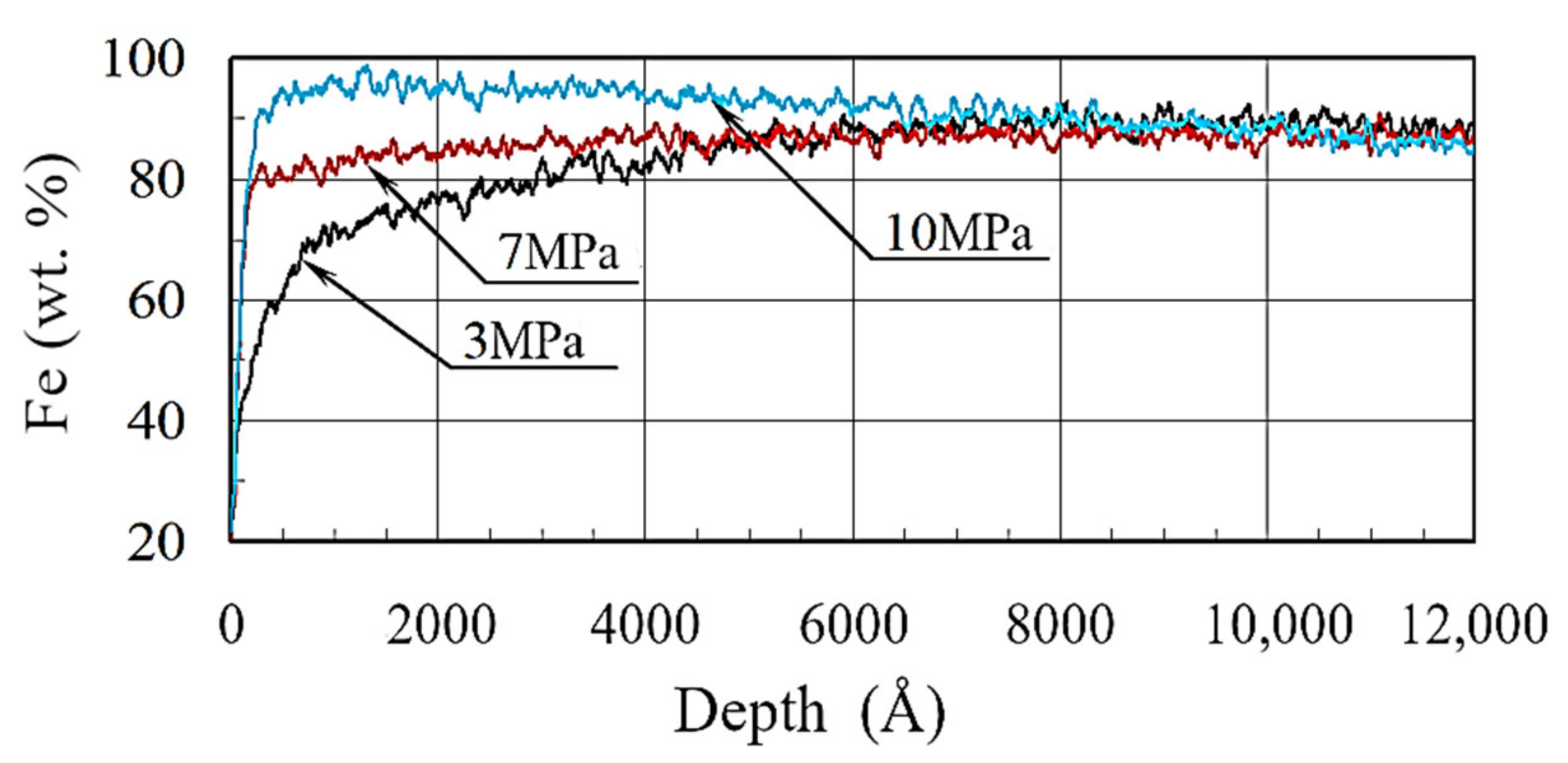
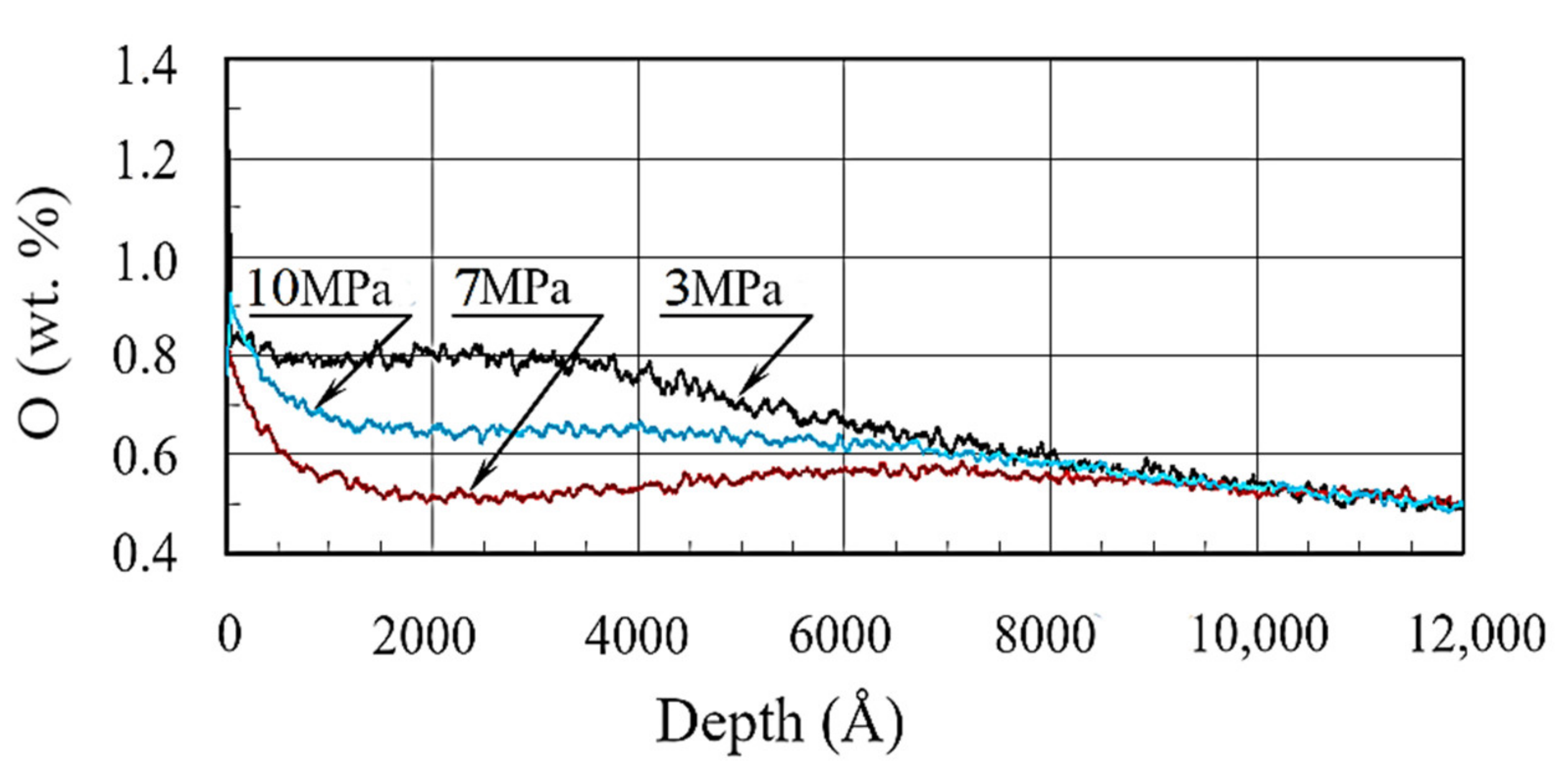

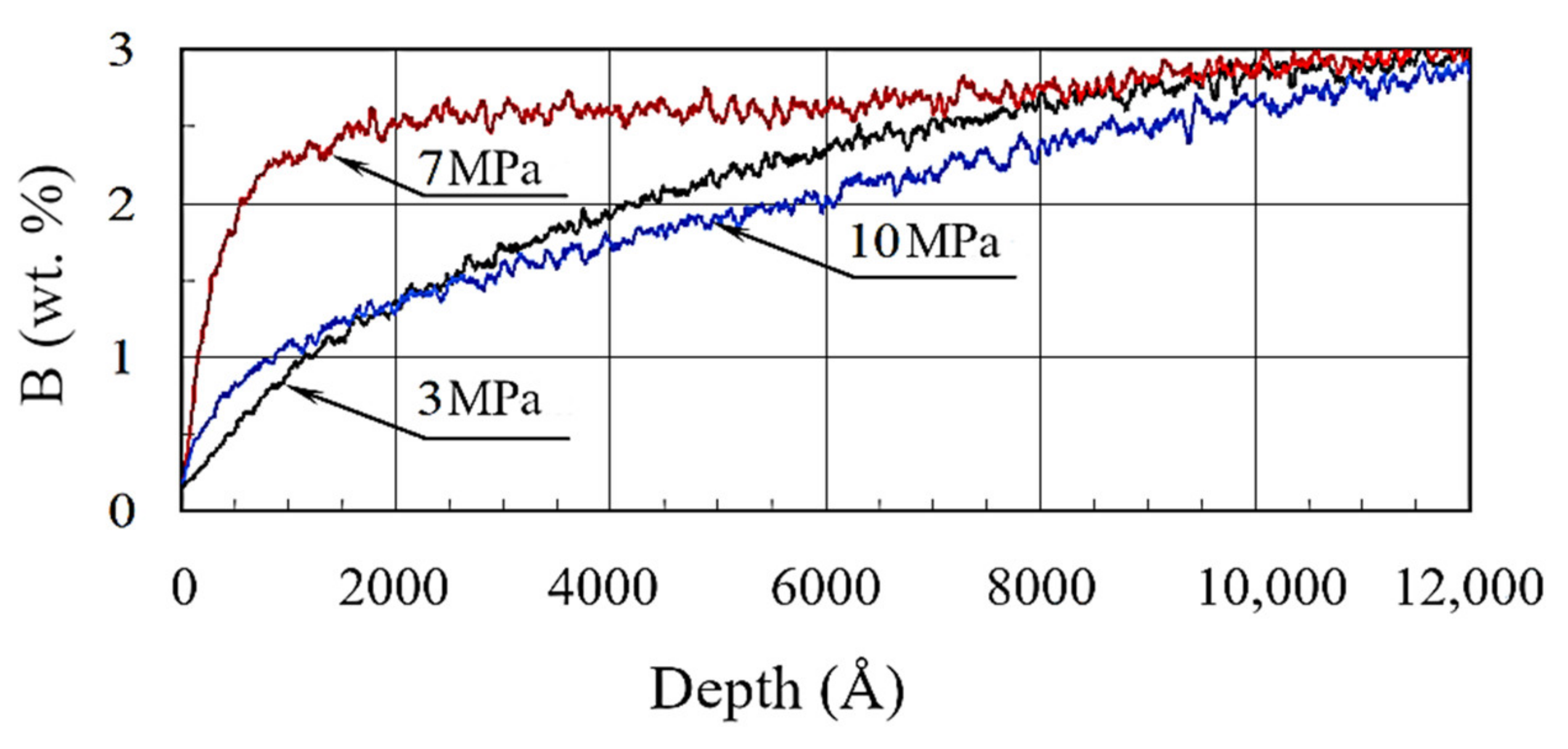
| Material | Element (wt.%) | ||||||
|---|---|---|---|---|---|---|---|
| C | Mn | Si | Cr | Mo | Ni | Fe | |
| C45 | 0.42–0.50 | 0.5–0.8 | 0.1–0.4 | 0.3 | 0.1 | 0.3 | Balance |
| Chemical Element | Coating Nominal Composition (wt. %) | Coating Composition after Wear Test at Specific Pressure 3 MPa, (wt. %) | Coating Composition after Wear Test at Specific Pressure 3 MPa, (wt. %) | Coating Composition after Wear Test at Specific Pressure 3 MPa, (wt. %) | |||
|---|---|---|---|---|---|---|---|
| On Surface | On Depth of 100 Å | On Surface | On Depth of 100 Å | On Surface | On Depth of 100 Å | ||
| Al | 2.7–4.4 | 7.6 | 10.9 | 3 | 3.2 | 6.6 | 3.76 |
| Si | 0.23–0.3 | 0.8 | 0.7 | 0.6 | 0.7 | 0.8 | 0.95 |
| Cr | 0.2–0.4 | 0.9 | 1 | 0.3 | 0.3 | 0.4 | 0.7 |
| Mn | 0.3–0.4 | 0.2 | 0.45 | 0.2 | 0.3 | 0.3 | 0.9 |
| Na | 2.3–5.1 | 7.2 | 6.4 | 51.8 | 14.1 | 18.1 | 8.6 |
| B | 2.9–3 | 0.2 | 0.2 | 0.2 | 0.6 | 0.2 | 0.4 |
| C | 0.5 | 0.92 | 1 | 0.7 | 0.99 | 0.6 | 0.9 |
| O | 0.5 | 1.45 | 0.8 | 0.8 | 0.8 | 0.8 | 0.9 |
| Fe | Balance | 22.6 | 42.1 | 19.9 | 61.7 | 21.5 | 62.5 |
Publisher’s Note: MDPI stays neutral with regard to jurisdictional claims in published maps and institutional affiliations. |
© 2020 by the authors. Licensee MDPI, Basel, Switzerland. This article is an open access article distributed under the terms and conditions of the Creative Commons Attribution (CC BY) license (http://creativecommons.org/licenses/by/4.0/).
Share and Cite
Pashechko, M.; Dziedzic, K.; Jozwik, J. Analysis of Wear Resistance of Borided Steel C45. Materials 2020, 13, 5529. https://doi.org/10.3390/ma13235529
Pashechko M, Dziedzic K, Jozwik J. Analysis of Wear Resistance of Borided Steel C45. Materials. 2020; 13(23):5529. https://doi.org/10.3390/ma13235529
Chicago/Turabian StylePashechko, Mykhaylo, Krzysztof Dziedzic, and Jerzy Jozwik. 2020. "Analysis of Wear Resistance of Borided Steel C45" Materials 13, no. 23: 5529. https://doi.org/10.3390/ma13235529
APA StylePashechko, M., Dziedzic, K., & Jozwik, J. (2020). Analysis of Wear Resistance of Borided Steel C45. Materials, 13(23), 5529. https://doi.org/10.3390/ma13235529







